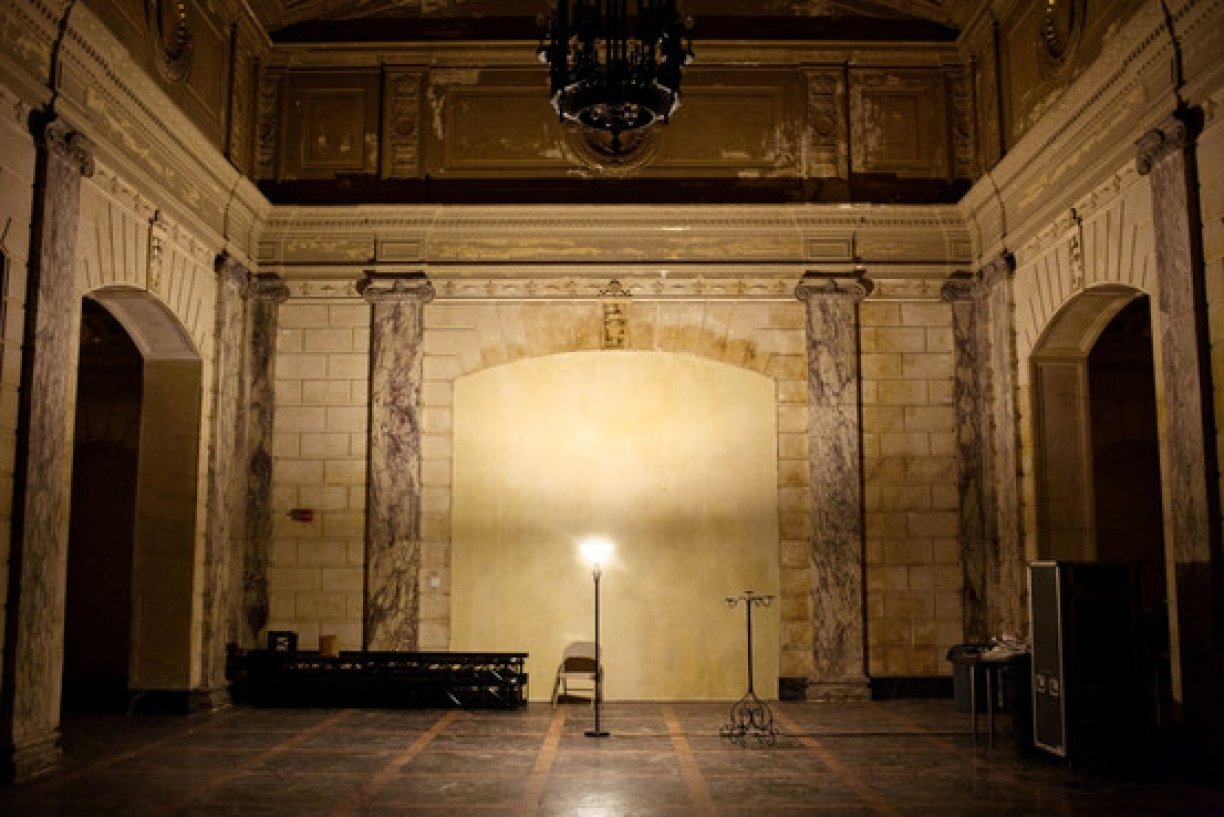Issue Project Room Withstands Its Growing Pains
Andy Battaglia in the Wall Street Journal, 1/15/13
On a quiet afternoon last August, in one of many unusual scenarios staged at Issue Project Room’s new performance space in Downtown Brooklyn, the sky came crashing down. Or, at least, part of the ceiling did—a 50-pound mass of plaster ensconced in the upper reaches of the stately historical building designed in 1926.
The occasion was a shoot for the HBO series “Boardwalk Empire,” which had rented the space and converted it, temporarily, into a Turkish bathhouse. “There’s a character who goes there to put a hit on a gangster, but then the tables get turned,” said Steve Buscemi, the show’s star. “They filmed the beginning of a scene, but they had to stop because the ceiling fell. Thank God no one was injured.”
The accident halted production and forced the “Boardwalk Empire” creators to make adjustments to the plot. (The show’s fans will wonder if they might have witnessed the end of Owen Slater.) “It worked out better for the story,” Mr. Buscemi said. “Unfortunately, it didn’t work out so well for Issue.”
Mr. Buscemi would know. A member of Issue Project Room’s board of directors, he has been involved with the organization since its formative years as a fledgling venue in the East Village, where it started in 2003 before moving to Gowanus and then, a year ago, to its current home at the corner of Boerum Place and Livingtson Street, growing in size and stature all the way.
But now, as the storied home for experimental music and performance enters its 11th year, it is being forced to orchestrate changes to the way it operates. The incident with the ceiling required months’ of scheduled programming to be moved to other locations. It also echoed, in an uncanny fashion, a kind of predicament that can beset small arts organizations presented with possibilities for growth but charged, too, with learning how to thrive on the fly.
Last month, while operating in a wayfaring state as a result of damage to its home, Issue Project Room set about restructuring—again. It parted ways with its executive director, Ed Patuto, who had been brought in only two years before to broker its move from the tiny industrial loft near the Gowanus Canal to the illustrious Renaissance-revival-style building at 110 Livingtson.
“It had been discussed since the ceiling fell, what structures would be needed and what would be possible considering that we would be homeless until we finished construction,” Mr. Patuto said.

From the start, plans for the new city-granted space had called for eventual closure for renovation, but not when the aged ceiling preferred. Now in limbo as those plans progress, Issue Project Room is communing again with its upstart roots—and looking to further its sense of purpose for the future. Stewardship will now be shared by 30-year-old Lawrence Kumpf, an Issue curator recently promoted to artistic director, and Tony Conrad, a longtime supporter and legend of New York avant-garde music and film who will take on elevated duties as artistic chair of the board.
“We’re going to be semi-nomadic,” Mr. Kumpf said of plans in place until a projected return to the renovated home on Livingston Street in 2015. “But for me, absolutely the most important thing is strategizing to keep the level of intimacy, interaction and openness toward the audience that has always been a big part of Issue’s programming. It’s essential that this be a community activity.”
To expand its own community, Issue Project Room is partnering with other groups and plans to present, in addition to one-off productions, four regular events a month at 155 Freeman St., a Greenpoint building shared by the online arts magazine Triple Canopy, the experimental film-exhibition venue Light Industry and the Public School, an open-source education center that offers free classes on arcane subjects to adults.
“It’s a perfect meeting of the minds in a lot of ways,” said Mr. Kumpf, who is 30. “These are people who have been in the same cultural milieu as us.”
Said Eve Essex, Issue Project Room’s 27-year-old marketing and outreach director, “Going into 155 Freeman, there is the same kind of energy. It’s a lot of young people who are our peers, and there’s not this sort of hovering institution over what you’re allowed to do.”
Other plans for the year include the development of an online magazine, a publication series (to begin with a book of collected artist writings) and a music imprint in collaboration with the dynamic Massachusetts label Important Records. While work with architects advances to make the home building hospitable again, amended plans in place put Issue Project Room in a position to re-identify with its shifting mission from the beginning.
“Because of the nature of how we have to collaborate, our vision changed,” Mr. Kumpf said. “But Issue’s most specific directive is working with emerging artists and providing a forum for critical context that goes beyond an enrichment of culture through the arts. Every year I become more and more excited about work that’s being produced in Brooklyn. It’s an extremely exciting time.”
A version of this article appeared January 16, 2013, on page A15 in the U.S. edition of The Wall Street Journal, with the headline: The Light Remains Bright, but Nobody’s Home.
http://online.wsj.com/article/SB100014241278873235962045782439118385674…

